Beneficial
dull tumblebug
Family: Scarabaeidae Subfamily: Scarabaeinae Genus: Canthon Species: Canthon pilularius (Linnaeus, 1758)
none available
Total body length 12.0–19.0 mm (0.39–0.59 in). Body shape round (dorsal view); may be caked in dried dung. Color variable; dull, velvety black to dull, bronze or green. Eyes crescent shaped, longer than wide. Clypeusclypeus:
part of the head anterior to the frons; the most anterior portion in dorsal view
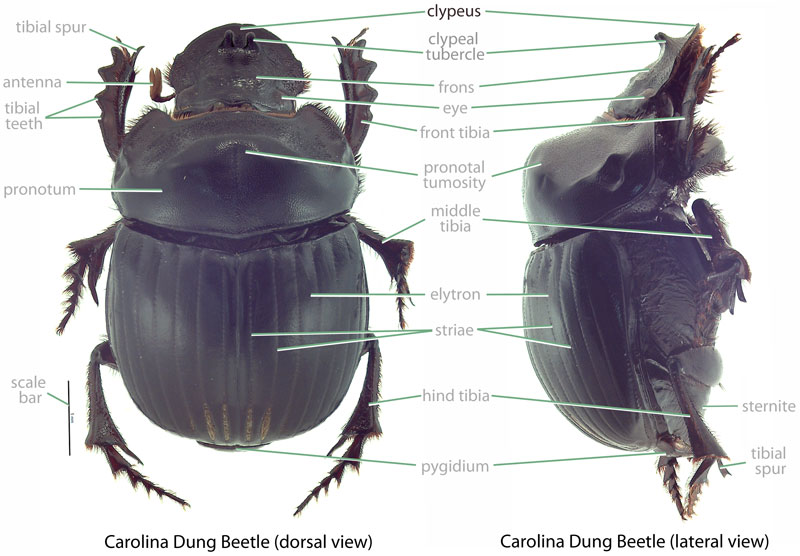 bidentatebidentate:
bidentatebidentate:
a surface that is sharply notched, usually resulting in two tooth-like protrusions on each side of the notch
; surface coarsely granulategranulate:
relating to a coarse, grainy surface texture
. Pronotumpronotum:
the dorsal surface of the thorax
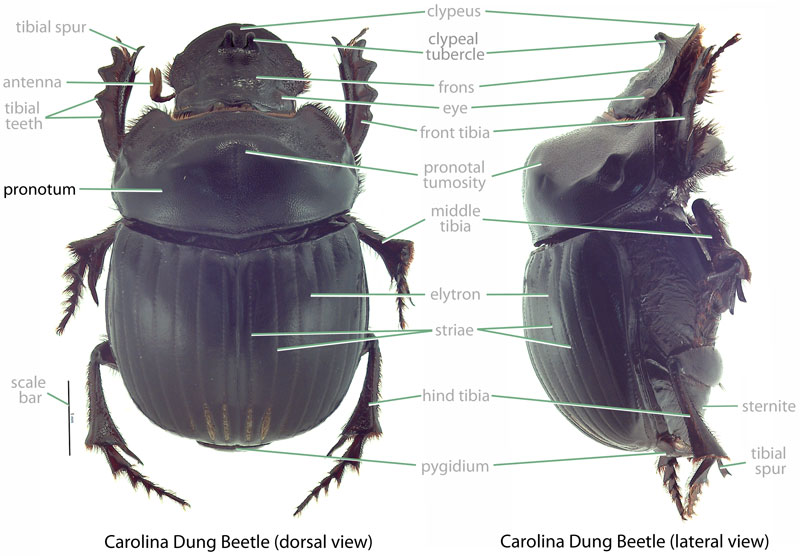 and elytraelytra:
and elytraelytra:
the hardened and chitinous wing-cover of a beetle that protect and overlie the flight wing
coarsely granulategranulate:
relating to a coarse, grainy surface texture
. Front tibiatibia:
a segment of the leg articulated with the tarsus and femur
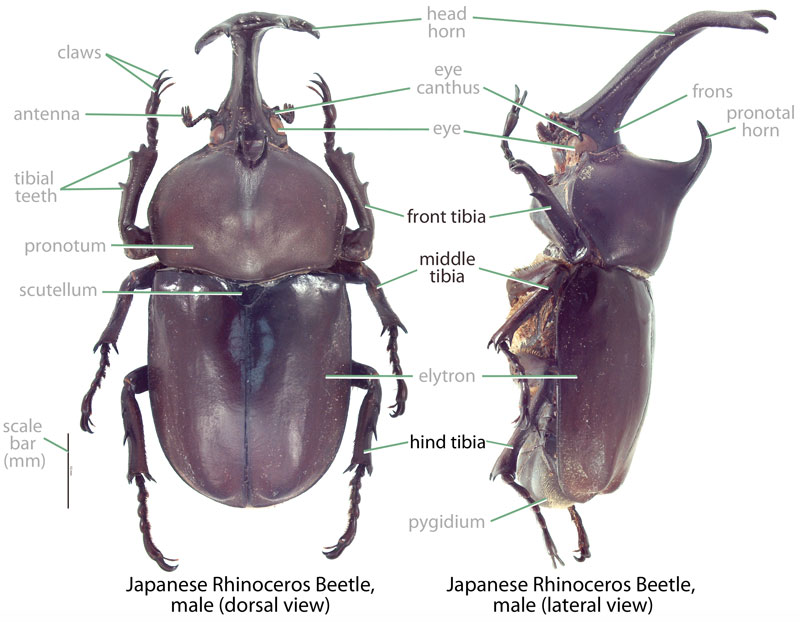 with apical spurspur:
with apical spurspur:
movable, spine-like process, sometimes mobile, often found at or near the tibial apices
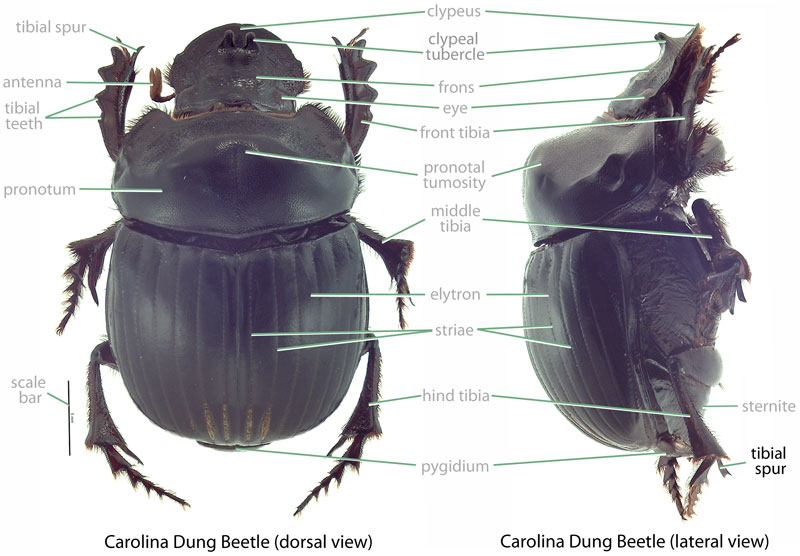 bifurcatebifurcate:
bifurcatebifurcate:
a process dividing into two points
in male and spine-like in female (spur may be worn down in older individuals). Middle and hind legs elongate. Pygidiumpygidium:
the last abdominal segment, usually exposed, not completely covered by the elytra
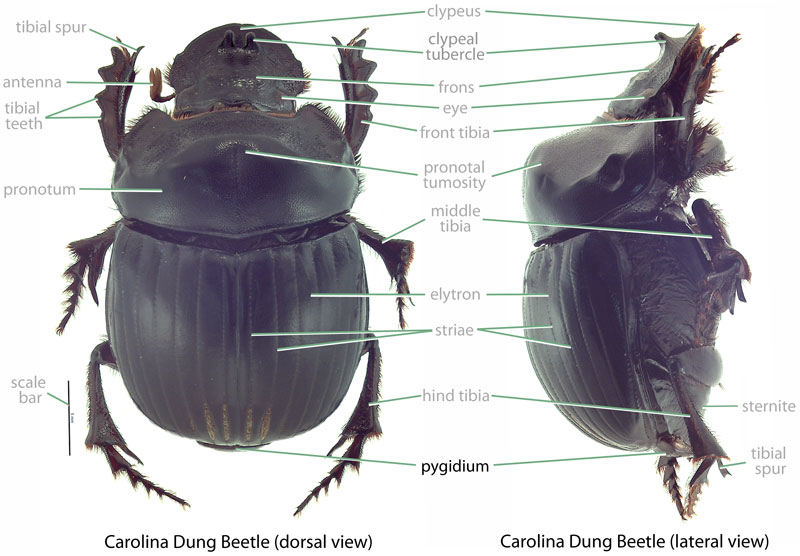 width less than twice the height.
width less than twice the height.
(Ritcher, 1966Ritcher, 1966:
Ritcher P. 1966. White grubs and their allies: a study of North American scarabaeoid larvae. Oregon State University Monographs, Studies in Entomology 4: 1-219.): Grub C-shaped, hump-backed, cylindrical, whitish. Anal slit transversetransverse:
extending horizontally across a surface
. Chaetopariachaetoparia:
inner, bristle-covered portion of the paria
 each with 7–9 setaesetae:
each with 7–9 setaesetae:
small, hair-like structure
. Maxillary stridulatory area with 12–17 teeth. Prothoracic shieldprothoracic shield:
the chitinous plate behind the head of larvae
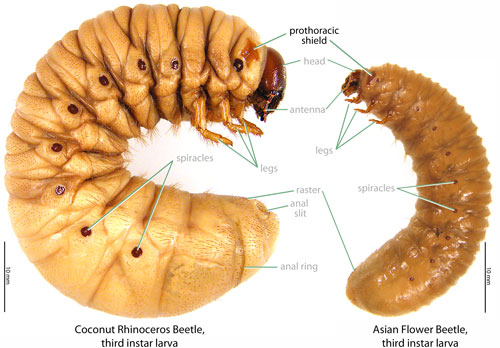 with anterioranterior:
with anterioranterior:
the front or forward; opposite of posterior
projecting, angular process on each side. Legs each with a single long, terminal setaseta:
small, hair-like structure
surrounded by 8–9 short setae; 2-segmented; without stridulatory structures; claws absent. Venter of last abdominal segment with single, broad, caudalcaudal:
oriented towards the posterior
, median lobe flanked by 2 smaller fleshy lobes; median lobe with 2 inconspicuous patches of very short setaesetae:
small, hair-like structure
.
Eastern North America. This species is common and widespread across the eastern U.S., occupying much of the area east of the Rocky Mountains and south of the boreal forest (Woodruff, 1973Woodruff, 1973:
Woodruff R. 1973. The scarab beetles of Florida (Coleoptera: Scarabaeidae) part I. The Laparosticti (Subfamilies: Scarabaeinae, Aphodiinae, Hybosorinae, Ochodaeinae, Geotrupinae, Acanthocerinae). Arthropods of Florida and Neighboring Land Areas 8: 1-220.).
None. This species feeds on dung as both an adult and larvalarva:
the immature form of an insect; in scarabs, also called grub or white grub; preceded by the egg stage, followed by the pupal stage
 (Woodruff, 1973Woodruff, 1973:
(Woodruff, 1973Woodruff, 1973:
Woodruff R. 1973. The scarab beetles of Florida (Coleoptera: Scarabaeidae) part I. The Laparosticti (Subfamilies: Scarabaeinae, Aphodiinae, Hybosorinae, Ochodaeinae, Geotrupinae, Acanthocerinae). Arthropods of Florida and Neighboring Land Areas 8: 1-220.).
Canthon pilularius favors open habitats where it feeds preferentially on horse and cattle dung (Woodruff, 1973Woodruff, 1973:
Woodruff R. 1973. The scarab beetles of Florida (Coleoptera: Scarabaeidae) part I. The Laparosticti (Subfamilies: Scarabaeinae, Aphodiinae, Hybosorinae, Ochodaeinae, Geotrupinae, Acanthocerinae). Arthropods of Florida and Neighboring Land Areas 8: 1-220.). On fresh dung, several hundred individuals may congregate to feed and mate (Ratcliffe and Paulsen, 2008Ratcliffe and Paulsen, 2008:
Ratcliffe B and Paulsen P. 2008. The scarabaeoid beetles of Nebraska (Coleoptera: Scarabaeoidea). Bulletin of the University of Nebraska 22: 138-248.). Dung balls are created and rolled only by the males with females often riding passively atop the balls (Woodruff, 1973Woodruff, 1973:
Woodruff R. 1973. The scarab beetles of Florida (Coleoptera: Scarabaeidae) part I. The Laparosticti (Subfamilies: Scarabaeinae, Aphodiinae, Hybosorinae, Ochodaeinae, Geotrupinae, Acanthocerinae). Arthropods of Florida and Neighboring Land Areas 8: 1-220.). Dung balls may be either eaten by the adults or buried and used for rearing larvaelarvae:
the immature form of an insect; in scarabs, also called grub or white grub; preceded by the egg stage, followed by the pupal stage
 . Dung balls used for larvaelarvae:
. Dung balls used for larvaelarvae:
the immature form of an insect; in scarabs, also called grub or white grub; preceded by the egg stage, followed by the pupal stage
 each hold a single egg and are buried 7.6–12.7 cm (3.0–5.0 in) deep in firm soils (Ritcher, 1966Ritcher, 1966:
each hold a single egg and are buried 7.6–12.7 cm (3.0–5.0 in) deep in firm soils (Ritcher, 1966Ritcher, 1966:
Ritcher P. 1966. White grubs and their allies: a study of North American scarabaeoid larvae. Oregon State University Monographs, Studies in Entomology 4: 1-219.). In the laboratory, development from egg to adult ranged between 29 and 44 days (Ratcliffe and Paulsen, 2008Ratcliffe and Paulsen, 2008:
Ratcliffe B and Paulsen P. 2008. The scarabaeoid beetles of Nebraska (Coleoptera: Scarabaeoidea). Bulletin of the University of Nebraska 22: 138-248.).
None. This species recycles dung and is beneficial for ranching and farming in Hawaii. Being an obligate dung feeder, this species poses no threat to crop or ornamental plants. Additionally, this species is not a threat to native dung beetles because none are known from Hawaii or Guam.
Established. This species was intentionally released on Oahu in August of 1963 (Hawaiian Entomological Society, 1964Hawaiian Entomological Society, 1964:
Anonymous. 1964. Notes and exhibitions. Proceedings of the Hawaiian Entomological Society 18: 344-347. full text (accessed 2015)). Similar dung beetle introductions were undertaken to help control populations of the horn fly (Haematobia irritans), a biting pest of livestock (Markin and Yoshioka, 1998Markin and Yoshioka, 1998:
Markin G and Yoshioka E. 1998. Biological control of the horn fly, Haematobia irritans L., in Hawai'i (Diptera: Muscidae). Proceedings of the Hawaiian Entomological Society 33: 43-50. full text (accessed 2015)). It is established on Oahu (Nishida, 2002Nishida, 2002:
Nishida G (editor). 2002. Hawaiian terrestrial arthropod checklist, fourth edition. Bishop Museum Technical Report 22: 1-313.).
Not established or recorded. There are no records of this species from Guam.
In Hawaii, this species was intentionally released.
This scarab is one of four Canthon species recorded from Hawaii (none are known from Guam). It is distinguished from the other Canthon species recorded in Hawaii by examination of the pronotal texture (texture coarsely granulategranulate:
relating to a coarse, grainy surface texture
in Canthon pilularius versus smooth in C. viridis, C. indicageus and C. humectus), color (velvety black, bronze or green in Canthon pilularius versus shining green or red in Canthon viridis, dark blue-black in C. humectus), size (12.0–19.0 mm [0.39–0.59 in] in C. pilularius versus 2.0–4.0 mm [0.08–0.16 in] in C. viridis), and shape of the pygidiumpygidium:
the last abdominal segment, usually exposed, not completely covered by the elytra
 (pygidium width less than twice the height in Canthon pilularius versus width more than twice the height in C. humectus).
(pygidium width less than twice the height in Canthon pilularius versus width more than twice the height in C. humectus).
Scarabaeus pilularius Catesby, Scarabaeus laevis Drury, Scarabaeus hudsonias Forster, Scarabaeus volvens Fabricius, Coprobius obtusidens Ziegler, Canthon laevis Horn
Report your observation of this beneficial species at our iNaturalist project.